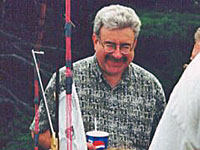
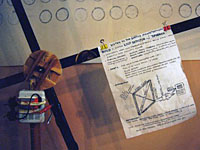
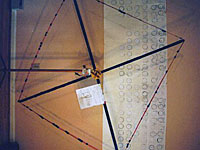
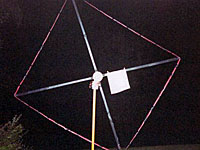
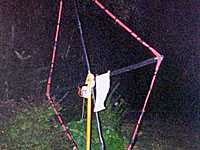
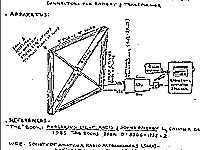
|
by John Avallone, Northern Virginia Astronomy Club
(NOVAC)
of Alexandria, Virginia
2000-Aug-25
The "antenna on the hill" at this year's Stellafane was a simple loop detector for
"SPHERICS". Its function is to directly convert very-low-frequency (10 to 10,000 Hz) electromagnetic noise into
acoustic sound at the same frequencies. Thus you can hear the otherwise inaudible natural atmospheric noises
termed spherics. Some level of noise activity is always present. It was interesting to watch people start to
walk by, only to stop in surprise and lean over to hear better, as they realized that the detector was "on" and
working.
Typical "natural" sounds are: clicks, pops, and tweets (short duration impulsive signals
generated by near and far lightning); whistlers (short tones descending from 10 kHz down to 10 Hz generated by
near-by lightning impulses spread out in frequency as they travel along the geomagnetic field lines to the
conjugate point and back); and the "dawn chorus" (half-second tones rising from 1 to 4 kHz, possibly associated
with auroral-induced electrojet currents in the ionosphere). Of course, you almost always hear some 60 Hz hum
from electrical lines and equipment.
The loop is easy to build. It consists of 90 feet of #22 insulated solid copper wire wound in
5 turns (1/4" apart) around a wood "X" frame. The two pieces of wood for the "X" are 6 feet long, so the wire
run is about 4 feet on a side. The start and finish ends of the wire are connected to the red and white input
leads of a 5 Ohm to 2 kOhm matching audio transformer (Radio Shack # RS 273-1380). The green and blue output
wires from the transformer are connected to an amplifier/speaker (Radio Shack #RS277-1008A). The construction
was outlined on a single-sheet plan that I distributed at STELLAFANE. All 40 copies went quickly!
I like to have the loop running nearby while observing. Its fun to hear what's going on in
the ionosphere while stargazing. With different (shortwave) equipment, its also interesting to listen at 21 MHz
to the radio noise roaring and surging in from Jupiter (Jovian whistlers?) while observing Io at maximum
elongation.
Here are some links for the 21 MHz Jupiter signal and also for the spherics loop antenna:
|